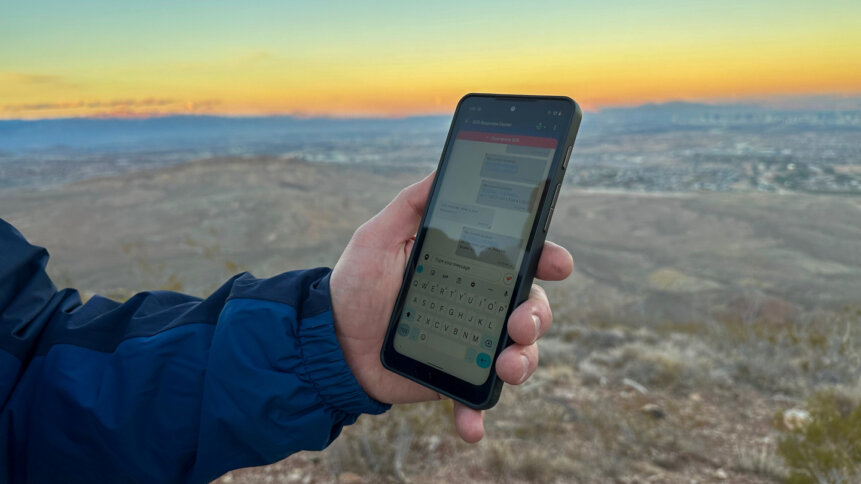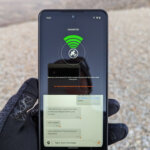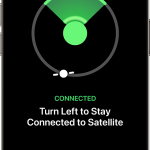Leading the charge towards satellite smartphones

|
Getting your Trinity Audio player ready...
|
In Part 1 of this article, we sat down with Richard Wharton and Jonathan Nattrass, co-founder and Chief Product Officer respectively at Bullitt Group, a UK maker of rugged technology which was actually first to develop satellite smartphones, to talk about the race of the industry’s big players, like Apple, and latterly the combination of Iridium and Qualcomm, to get into “the next big thing” in smartphone must-haves.
While we had them in the chair, we took the opportunity to discuss the journey in broader terms.
THQ:
Bullitt is presenting new handsets at the Mobile World Congress in Barcelona in February. Is it fair to say you’re about to leapfrog both what Apple has done and the new Qualcomm proposal?
RW:
Yes, that’s fair. We’ve just come from CES in Vegas, and the Qualcomm demo was clearly done on a demo board. People weren’t able to touch or feel the device that they had, where ours was a fully functioning service in customer-ready devices, and offering both SOS and two-way messaging. Apple are still on SOS-only at this point. We don’t know what their plans are, obviously. But yes, it looks very much like we are going to be the first to achieve both SOS and two-way messaging. And I think it’ll be many months before anyone catches up.
Two-way messaging – now.
THQ:
That’s the point, isn’t it? The big boys may be starting on their journey towards satellite smartphones, but their offerings very much feel like the beginning of the journey – SOS-only, available only in flagship (which means expensive and probably trendy) devices. Bullitt on the other hand – boom: here’s ubiquitous two-way messaging as well as SOS emergency texting, oh and by the way, it’s available on cellphones at all price points. That feels like it should be a much easier sell to the public.
RW:
Well I mean, why wouldn’t you want the ability to be sure of your ability to communicate, both ways? It’s just another layer of reassurance. And in terms of the price plan, £4.99 a month for up to 30 messages is accessible to lots of people, and you don’t have to have a flashy, top-of-the-range phone – because we started doing this not for people who could pay the most, but people who needed rugged devices, which meant they were most likely to be in signal-compromised areas.
That holds true – why should you only get this if you’re rich enough to afford the premium devices in this economy? We think that the fact that you can bounce 30 messages per month off a satellite 22,000 miles in the sky for £4.99 is that step-change the whole idea of satellite smartphones needs. It offers that ubiquity of use, but it’s affordable and available to all. Just to have that knowledge, that reassurance that you’ve got that in your pocket, and if you do need it, it’s there.
The time has come.
THQ:
That reassurance is presumably going to play into the marketing campaigns of Apple and the others eventually. And it feels like a natural evolution of the smartphone offering – after all, we’ve been using satellites for navigation for decades now, and most smartphones come with at least thee satellite receivers for that function now, because at least three satellite constellations for that purpose are now mature – GPS, GLONASS, and GPS. So it feels like an easy shift to move the conversation onto satellite communication in a smartphone. Why would you not take it to that next level?
RW:
Exactly. And I think it’s going to play a much bigger role going forward in the whole mobile ecosystem. A lot of people see this this coming, but it’s much easier to put that burden on the device. I see manufacturers who just need to add a chip and connect to existing spectrum. Although obviously there are limitations in what their satellite providers can deliver.
I mean, the idea that SpaceX could deliver a solution in the next 12 months is far-fetched, because it’s going to have to build new satellites because its current satellite constellation doesn’t support this type of application, you still need a big dish antenna to receive it. The geostationary operators that we’re working with – Inmarsat, EchoStar, etc – offer all the spectrum that we need to deliver the service and move forward into 5G new radio.
5G new radio.
THQ:
For those just joining us, 5G new radio is a coming standard that will allow satellite smartphones to do much more than send and receive text messages – it will open them up to images and video.
RW:
While today, there’s this sense in some of the other offerings that it has to be an emergency text, or it has to be mission-critical or business-critical – which really restricts the number of people who think they actually need it – by the time you get to 5G new radio, you’re opening it up to the tens of millions of people that go hiking, you open it up to the skiers, the small boat yachties. There are 6 million private boats parked up on the map, and you quickly lose signal when you go offshore. So, there are broader consumer use cases outside of the mission and business-critical stuff.
And beyond that, when you have 5G new radio, it really delivers a much richer suite of services, where you can start sending pictures and videos, and then doing VoIP calls. It totally, totally changes the environment. Not-spots, breaks in signal coverage, will be a thing of the past, because the satellites are way overhead.
And then obviously, there are applications for military customers. As we’re seeing for instance, the Ukrainian communications infrastructure is being destroyed. This is very quick and easy to deploy in any negative event, whether it’s a natural disaster or a conflict. So for instance, in the US hurricane that hit Florida recently, suddenly a million people were without communication and power for over a week, and even the emergency services were struggling with communication.
Solving that with standard terrestrial signal technology, you’d have to set up base stations and terminals. And with satellite smartphones, if you have one, you don’t have the outage in the first place because you have an alternative, never-down source of connectivity.
Not-spots – nevermore.
THQ:
Just for the sake of clarity, we’re saying that, as you say, in the US, no one cell signal carrier has coverage over more than 70% of the landmass. Are we genuinely expecting that the infill will be one up to 100% once satellite smartphones achieve ubiquity?
RW:
Within around five degrees from either pole, yes, because it’s useful wherever you can see the sky.
JN:
The satellite coverage is ubiquitous over the States and ditto over Europe. So you know, maybe if you’re down a canyon or a ravine somewhere, it might be a little difficult. There might be other conditions, but generally, yes, coverage is ubiquitous, so connectivity will be too.
THQ:
It all feels like the start of an exciting technological journey, but it also feels like the expected norm of the next generation, doesn’t it? Like when the first cellphones were emerging, or the internet, or Google?
JN:
Yes. And I think that was very much the driver behind the 3GPP standards work – people recognized that operators couldn’t economically provide 100% of landmass coverage. As Richard said, they’ve done a good job with the standard population. But obviously, as people move around, either as part of their hobbies or their daily working lives, it’s just impossible to provide 100% coverage. So this is the start of a journey where coverage starts to become more and more prevalent.
The long think.
THQ:
What’s the history here? Our readership is not general, but the general public will have pricked up their ears to the idea of satellite smartphones only when Apple delivered the iPhone 14. How did Bullitt come to be where it is? By all objective observation, ahead of the game?
RW:
We’ve been thinking about it longer.
Our traditional customers needed rugged machines, and they used them in places where they were likely to lack signal. So we had a market for devices that could fill that gap, and satellite connectivity was the best way to do that. And we had that market long before Apple or any of the Android OEMs saw the need.
So we’ve really thinking about it for a long time. And then, you know, Jonathan joined us from Inmarsat as our Chief Product Officer in March, 2021 and the whole thing took off. That’s when it all started to become achievable and doable. So it’s a strange conversation, right? “How have you guys managed to beat Apple and Samsung and everybody else to the punch on this one?”
THQ:
We were trying to make it more tactful than that.
RW:
We get that from a lot of people, don’t worry.
Apple has spent hundreds of millions to get to where we are. I think we’ve been a little bit smarter by using a standards-based approach because it means it’s much more scalable. It means that we’re not reliant on a single satellite network. And Iridium doesn’t really have a roadmap to 5G new radio for the next seven years. So you’re stuck with a messaging-only service. We have the ability to operate with both geostationary and LEO satellites going forward, so we have a greater flexibility.
THQ:
It’s going to be an interesting journey, one way or the other. Here’s to it!










